#phython
Explore tagged Tumblr posts
Text





GOT7 PYTHON - Youngjae
21 notes
·
View notes
Text
#Python is among the most widely used and popular programming languages because of its flexibility in web development, data analysis, and artificial intelligence. Solving coding challenges is also one of the most effective ways to enhance your learning, preparing you for more complex development. Let's understand each of them in detail in the subsections below.
0 notes
Text
SANHIT:💻 Online Coding Classes – Learn, Build & Succeed!** 🚀✨
Master Python, Java, Web Development & more with expert mentors. 📢 Enroll now & start your coding journey today! ✅
visit the link to get more details:https://www.instagram.com/p/DGpQZayJTKQ/?igsh=cDlybzIxdjBnYXdv
0 notes
Text

webs jyoti institute in gurgaon the best it institute for web devlopment digital marketing
0 notes
Text
Every day this December I walk into the office room I share with my partner where I find them gnashing teeth because they can't find out what about their code is broken and I, not being able to code much of anything, ask all the right questions until they figure it out.
It's beautiful, I feel like I have a super power. Why DO advent of code when I can just become an expert debugger for my partner.
0 notes
Text
Asociación del consumo de alcohol en la adolescencia y el trabajo en la vida adulta
Ejecución de programa en Python
PASO 1: Ejecute su primer programa.
Importación de las librerías y de la base de datos NESARC.

2. Exploración el tipo de datos que incluye la variable.

3. Variable independiente.

4. Frecuencia de las covariables
Género

Ascendencia


Grado de estudios

5. Variable dependiente
Ocupación actual

Tipo de ocupación

Resultados
En la muestra del NESARC, la edad de inicio de consumo de alcohol se distribuye de la siguiente manera: el 5% de las personas comenzó a beber a los 17 años, el 12% a los 18 años, y el 7% a los 20 años.
En cuanto a la ocupación actual de los participantes, los tres resultados más importantes son: el 15% trabaja en finanzas, seguros y bienes raíces; el 17% se dedica a la minería; y el 14% trabaja en el sector agrícola.
Respecto al tipo de ocupación, los tres resultados más importantes son: el 24% se dedica al transporte y movimiento de materiales, el 13% a servicios de protección, y el 12% a producción de precisión, artesanía y reparación.
En cuanto al grado de estudios, los tres resultados más importantes son: el 25% completó la preparatoria, el 20% cursó algunos estudios universitarios sin obtener un título, y el 12% completó la universidad con un título de licenciatura.
En cuanto a la variable de género, el 57% de los participantes son mujeres y el 43% son hombres.
La ascendencia de los participantes, de acuerdo con el NESARC, el 17% se identificó como afroamericano (negro o afroamericano), el 12% tiene ascendencia alemana, y el 10% tiene ascendencia inglesa.
0 notes
Text
Python Certification Course in Rajkot
Why Opt for a Python Certification Course in Rajkot?
Rajkot is rapidly becoming a hub for technology and innovation, making it an ideal place to pursue a Python Certification Course. The city's growing tech landscape provides a robust platform for applying Python skills in real-world scenarios. Enrolling in a Python Certification Course in Rajkot ensures that you receive relevant, practical training tailored to local industry needs.
Course Overview
A top-tier Python Certification Course in Rajkot covers a range of topics designed to build a solid foundation in Python. Key areas typically include:
Python Basics: Understand fundamental concepts such as variables, data types, and control structures.
Advanced Python Techniques: Learn about advanced topics including decorators, context managers, and metaclasses.
Data Handling: Gain expertise in manipulating data using libraries like Pandas and NumPy.
Web Development: Explore frameworks such as Django or Flask to build and deploy web applications.
Automation and Scripting: Develop skills in creating scripts to automate tasks and processes.
Local Advantages
Choosing a Python Certification Course in Rajkot offers several benefits. Local courses often provide insights into regional market trends and connect you with a network of professionals and employers in Rajkot. This can enhance your job prospects and open doors to local career opportunities.
Enroll and Excel
Whether you’re a beginner or looking to upgrade your skills, the Python Certification Course in Rajkot can significantly boost your career. With expert instructors and a curriculum designed to meet industry standards, you’ll gain the skills necessary to succeed in the tech world.
To find the best Python Certification Course in Rajkot, research local training providers and select a program that aligns with your career goals. Invest in your future today and become a certified Python expert ready to tackle new challenges. TOPS Technologies
Address-101, Aditya Complex, Jalaram 2 Street Number 2, above Sbi Bank, Near Indira Circle, Jala Ram Nagar, Rajkot, Gujarat 360005
Phone-09724004242
0 notes
Text
Master Python with our Training in Marathahalli!
Learn from industry experts at Learn More Technology and build skills in coding, data analysis, and more. Enroll today and start your journey to becoming a Python pro!
0 notes
Text
ANOVA Analysis
Course "Data Analysis Tools" on the Coursera platform corresponding to week 01. The objective is to execute an Analysis of Variance using the ANOVA statistical test, this analysis evaluates the measurements of two or more groups that are statistically different from each other. It is mainly used when you want to compare the measurements (quantitative variables) of groups (categorical variables). The hypotheses are the following: H0="There is no difference in the mean of the quantitative variable between groups (categorical variable)" H1= While the alternatives there is a difference.
The Code in Phython
import numpy as ns import pandas as pd import statsmodels.api as sm import statsmodels.formula.api as smf import statsmodels.stats.multicomp as multi import matplotlib.pyplot as plt import seaborn as sns import researchpy as rp import pycountry_convert as pc
df = pd.read_csv('gapminder.csv')
df = df[['lifeexpectancy', 'incomeperperson']]
df['lifeexpectancy'] = df['lifeexpectancy'].apply(pd.to_numeric, errors='coerce')
def income_categories(row): if row["incomeperperson"]>15000: return "A" elif row["incomeperperson"]>8000: return "B" elif row["incomeperperson"]>4000: return "C" elif row["incomeperperson"]>1000: return "D" else: return "E"
df=df[(df['lifeexpectancy']>=1) & (df['lifeexpectancy']<=120) & (df['incomeperperson'] > 0) ]
df["Income_category"]=df.apply(income_categories, axis=1)
df = df[["Income_category","incomeperperson","lifeexpectancy"]].dropna()
df["Income_category"]=df.apply(income_categories, axis=1)
print (rp.summary_cont(df['lifeexpectancy']))

fig1, ax1 = plt.subplots() df_new = [df[df['Income_category']=='A']['lifeexpectancy'], df[df['Income_category']=='B']['lifeexpectancy'], df[df['Income_category']=='C']['lifeexpectancy'], df[df['Income_category']=='D']['lifeexpectancy'], df[df['Income_category']=='E']['lifeexpectancy']] ax1.set_title('life expectancy') ax1.boxplot(df_new) plt.show()
results = smf.ols('lifeexpectancy ~ C(Income_category)', data=df).fit() print (results.summary())
print ("Tukey") mc1 = multi.MultiComparison(df['lifeexpectancy'], df['Income_category']) print (mc1) res1 = mc1.tukeyhsd() print (res1.summary())
print ('means for for life expectancy by Income') m1= df.groupby('Income_category').mean() print (m1)
print ('Results') print ('standard deviations for life expectancy by Income') sd1 = df.groupby('Income_category').std() print (sd1)
Conclusions – ANOVA Analysis
An ANOVA test is carried out, integrated by 176 rows, 171 will be used for the test. A filter is applied to eliminate some incorrect values, such as non-numeric, negative, etc., reducing the rows of the original data set.
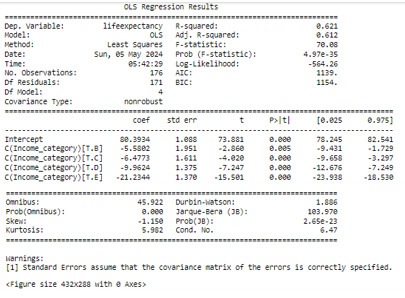
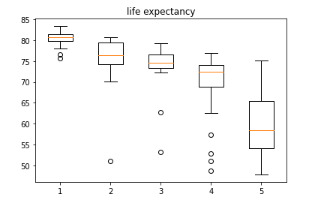
The ANOVA analysis shows a graph for each category (at the top) and, as can be seen, the life expectancy of class A, has a life expectancy of 80.39 years while the E class has a life expectancy of 59, 15 years
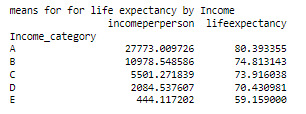
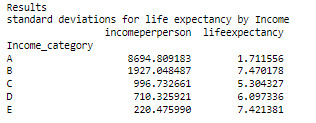
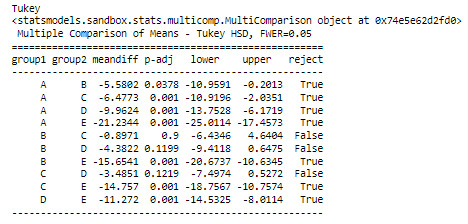
1 note
·
View note
Text
Career Options in Data Science
In an era of digitization and advanced technologies, data science plays a vital role in driving innovations, decisions, creativity, and success. It helps businesses identify challenges, trends, and new opportunities. Nowadays, it becomes important for each enterprise to add data science to its business operations to make a marked difference in product development, decision-making, and productivity levels.
Students across India are seeking a career in this field right after their higher studies. With the growing demand for data science courses, many schools and colleges are introducing graduate and undergraduate courses in data science. Apart from that, there is a wide array of data science online courses that learners can easily get on the leading eLearning portals.
What is data science?
Data science refers to the integrative approach that combines practices and principles from various fields, including computer engineering, statistics, artificial intelligence, and mathematics, to extract meaningful insights for business. It involves different tools, processes, and roles, enabling analysts to draw actionable insights that can guide strategic planning and decision-making. In addition, data science is a multidisciplinary concept and can be described as a research method, workflow discipline, and profession.
Courses offered in this field
Leading colleges and certification organizations are now offering courses in data science. Obtaining a bachelor's or master's degree is necessary to create a career in this sector. The list of courses, both undergraduate and graduate, is provided below.
Best Data Science Bachelor Degrees
Bachelor in Data Analytics
B.S. in Computer Science
Bachelor of Science in Healthcare Data Analytics
Bachelor of Data Science
B.Sc. in Applied Data Science
B.Sc. Data Science, Artificial Intelligence, and Digital Business
B.Sc. (Hons.) in Data Science
B.Sc. (Hons.) Computing
The Best Master's Degrees in Data Science
Master of Science in Data Science
Master of Science in Applied Data Science
Master of Science in Data Analytics
Master of Liberal Arts, Data Science
Master of Advanced Studies, Data Science, and Engineering
Master in Interdisciplinary Data Science
For more articles, please visit Daily Booster Article| study24hr.com
Top careers in data science
Here are some of the best career options and their roles, which you can choose according to your preferences.
Data Analyst
Data analysts deal directly with unprocessed information gathered by the systems. To process information, they collaborate with a variety of teams, including those in marketing, sales, customer service, and finance.
Data Engineer
Massive amounts of real-time data can be accessed and processed expertly by data engineers. They understand unformatted and unverified data, which is crucial for tech-driven businesses and departments.
Machine Learning Engineer
ML engineers develop software, ML models, and artificial intelligence (AI) systems to power various organizational activities.
Business IT Analyst
Business analysts search for chances to increase company income and growth while processing vast amounts of data.
Marketing Analyst
A market analyst excels at spotting changes in customer behavior, evaluating new buying patterns, and appraising the digital world for a company.
Skills required as a Data Scientist
To learn data science in depth, you need the following set of abilities as a data scientist:
Data Visualization
Statistical analysis and computing
Data Wrangling
Machine Learning
Mathematics
Processing large data sets
Programming language and database
Deep Learning
Best online data science education portals
As the educational system and business operations become more virtual, online data science courses are becoming more popular and in demand. It helps students upgrade their knowledge and generate insight to analyze data effectively and efficiently. Many top-notch data science websites and platforms can aid in the development of your skill set. Some of them are:
Codementor
At Codementor, you can find the best data science professionals, developers, consultants, and tutors. It is the best platform for studying the principles of data science, especially if you are a newbie. It provides a collaborative learning platform. To assist you in going deeper into the field of data science, it offers introductory courses, advanced courses, skill routes, and career paths.
Coursera
With Coursera, you can develop your data science career. This website offers Google Data Analytics certification to students. Any data scientist, marketer, or engineer would benefit from having this talent. Important subjects, including advanced statistics, cloud computing, and Google Analytics, are covered in this course.
ExcelR
One of the top data scientist education providers, ExcelR offers training courses on a wide range of in-demand professional skills to meet the demands of students and working professionals who are looking to upgrade their skill sets. It is regarded as the best data science training portal and provides services ranging from placement to training as a component of a training program for data science with more than 400 participants. Furthermore, a career in data science and analytics can be started with the help of the course material offered by ExcelR, which covers nearly all of the necessary topics.
“Study24hr.com” can assist you in gaining access to a wide variety of online courses. It is one of the greatest eLearning systems and seeks to develop an interactive and collaborative learning environment. The website offers students numerous tools like mock exams, quizzes, daily boosters, motivational films, and more. In addition, “Study24hr.com” permits educators to post their notes on their websites and receive leads from students.
Udemy
Another beneficial site for data science is "Udemy." Over 500 of Udemy's over 10,000 data science courses are free, making it a fantastic resource for data science. It provides data science students with the knowledge and skills they need to begin understanding programming languages, elementary statistics, linear algebra, and artificial intelligence.
edX
Since edX partners with top institutions, it will deliver top-notch data science training. Under this portal, you can study Python programming and deal with its numerous related data packages. These include Pandas, Numpy, and Matplotlib for data analysis, visualization, and computation. The site offers multiple courses to help you understand the areas and functions of data science and statistics. Moreover, edX enables you to make data-driven predictions by using probabilistic modeling and statistical inference while studying massive data.
In conclusion
We sincerely hope that this article provides you with a wealth of data science knowledge. All of the professional possibilities are fantastic and lead to prosperous outcomes. Choose the appropriate option and achieve your dreams if you are truly passionate about the field of data science.
#data science#data analytics#machine learning#artificial intelligence#skills#data science courses#study24hr#digital learning#phython#statistics#analytics
0 notes
Text
dzisiejszym poście przyjrzymy się skryptowi Pythona, który służy do generowania silnych haseł. Używa on interfejsu graficznego stworzonego za pomocą biblioteki Tkinter, co pozwala użytkownikom na łatwe wybieranie preferencji dotyczących długości hasła i rodzajów zawartych w nim znaków, takich jak wielkie i małe litery, cyfry oraz symbole. Hasło generowane jest poprzez losowe doborowanie znaków z zaznaczonych kategorii. Warto też zwrócić uwagę na komunikat o błędzie na dole zdjęcia, który sygnalizuje problem z wcięciem – typowy dla kodu Pythona, który wymaga szczególnej uwagi na strukturę wcięć.

0 notes
Text





GOT7 PYTHON - Group
13 notes
·
View notes
Text
Basic Programming Languages That Are Kid-Friendly
In today's digital world, knowing how to code is just as important as knowing how to read and write. When we introduce kids to computer programming languages at a young age, we are not just giving them technical abilities—we are opening the door to imagination, critical thinking, and problem-solving.
Mastering technology allows children to go from passive consumers to active creators, innovators, and solvers. Coding teaches kids to approach challenges logically, think through complex problems, and use their creativity to tell stories and design games. It's a skill that encourages curiosity and prepares children for a tech-filled future in every field.
Introduction to Programming for Kids
Programming is like giving instructions to computers to do cool things. It involves learning different coding languages to make software, apps, websites, and games. For kids, learning to code is like a whole new way of showing off their creativity and solving problems. It also helps them understand how all the digital stuff they interact with daily works. Plus, programming isn't just about technical skills. It also hones critical thinking, logical reasoning and the ability to tackle tough challenges. In a world where technology is everywhere, knowing how to code gives kids the power to create amazing things and opens the door to all kinds of future opportunities.
The need for coding skills is rising as technology shapes different industries. It's becoming a crucial part of education to give up the modern world. Schools are now including programming languages in their lessons Because it helps students think critically, solve problems, and be creative. By starting coding early, students are prepping for tech jobs and grasping the digital world better.
Programming plays a role in shaping future tech careers. Learning in-demand programming languages can help individuals kickstart their careers in software development and address the challenges beginners face in choosing a language to learn.
Why Are Languages of Programming Valuable in School Education?
Languages of Programming and programming knowledge, especially those of different programming languages, complement traditional education by fostering logical thinking and improving math, computer science concepts, logic languages, human language, and analytical skills.
Case studies or examples of how kids apply coding skills in real-world school projects demonstrate the practical benefits of learning to code in many programming languages. For instance, students have created apps to solve everyday problems, developed websites for school events, and even programmed robots for science fairs in other than the most popular programming languages ever. These projects enhance their basic understanding of various subjects and prepare them for future roles that may require proficiency in multiple programming languages.
Best Programming Language to Learn for Young Beginners
Simplicity and engagement are key when choosing the best programming language to learn. Scratch is widely used as a wonderful starting point for kids because of its easy-to-use block-based coding system, which allows them to create animations, games and stories without getting bogged down by complex syntax. This visual approach helps young learners adapt fundamental programming concepts like loops, variables and conditions in a fun and interactive way.
Another wonderful option is Python, an open-source programming language known for being user-friendly and versatile. Python is a top choice open-source programming language for children because it is simple and easy to read, making it easier for young children to build their problem-solving skills while creating projects like games and basic AI. Languages like Javascript and HTML/CSS are also the most popular languages of programming choices because they let kids bring their coding creations to life through interactive web pages. Ultimately, the best programming languages for young beginners depend on what they are most excited to learn and create.
Here's a breakdown of why each language is beginner-friendly and why other more in-demand programming languages are less accessible to new programming languages and young learners.
Scratch
Simplified surface: Instead of typing lines of code, Scratch uses colourful blocks that are easy to drag and drop, making it perfect for beginners.
Instant response—With Scratch, you can see the results of your code immediately, making it easier to learn from your mistakes and improve.
Fun and Interactive—From creating fun games to animated stories, Scratch keeps you entertained while you learn about coding.
Python
Easy-to-understand Syntax—Python's syntax is closest to natural languages, making it easy to read.
Adaptable—It is versatile, can be applied, and is widely used in web development, data science, and more, offering a world-rounded perspective.
Thriving community- Full of resources, libraries and support ready to help you
Java Script
Instant creations- See your creations come to life right in your browser, keeping you hooked and excited.
It's beginner-friendly, so you'll pick up the basics quickly and be able to create cool, interactive web pages easily.
In-demand-Mastering Javascript is a must for anyone interested in web development, giving you valuable hands-on experience.
Blockly
Block-based coding- Like scratch, blockly uses colourful texts to teach you programming concepts without worrying about syntax errors.
Instant Feedback—With Blocky, you can see how your code performs when you write it, making it easy to spot errors and grasp coding concepts in real time.
Fun and Functional- Blockly fosters creativity by allowing users to create various projects, from interactive puzzles to valuable prototypes. Learning coding skills has never been more engaging and interactive.
0 notes
Text

Become a part of the digital revolution with Megatask Web, a renowned web development Dubai firm proficient in PHP development, Java, Python, and .NET. Our team, composed of experienced and dedicated professionals, is ever-ready to deliver innovative solutions tailored to your exact needs. Prepare to be amazed by the reliable and state-of-the-art web solutions from Megatask Web, a proven Dubai web development company.
#web development#web designing#php#java#phython#react#angular js#wordpress development#shopify development
0 notes
Text

Mehwishtech company good company for best future. Mehwishtech company offer best coures such as java, phython, php, full stack. This company provide 100% placement and 50% discount per student fee. If you would like to start your career with with us , we will help you find a company and supported you in reaching your peak.
0 notes
Text
Title: Unleashing the Power of Python: A Versatile Programming Language by tpf shoot or digital photo factory
Introduction: In the world of programming, few languages have had the enduring impact and widespread adoption that Python has achieved. Python, developed by Guido van Rossum in the late 1980s, has become a go-to language for beginners and experts alike, thanks to its simplicity, versatility, and a thriving community of developers. In this blog, we will explore the reasons why Python has captured the hearts of programmers worldwide and why it continues to be a popular choice for a wide range of applications.
Simplicity and Readability: One of the key factors behind Python's popularity is its simplicity. Python's elegant syntax and clean design make it easy to read and understand. The use of indentation instead of braces for blocks of code encourages developers to write clean and well-structured programs. This simplicity lowers the barrier to entry for new programmers, allowing them to quickly grasp the fundamentals of programming and start building useful applications.
Versatility: Python's versatility is another major reason for its widespread adoption. Python can be used for a wide range of applications, from web development to data analysis, scientific computing, artificial intelligence, and more. It offers a vast ecosystem of libraries and frameworks that provide solutions for almost any programming task. For web development, frameworks like Django and Flask enable developers to build robust and scalable web applications. For data analysis and scientific computing, libraries like NumPy, Pandas, and Matplotlib provide powerful tools for data manipulation, analysis, and visualization. Python's versatility allows developers to switch seamlessly between different domains and tackle diverse programming challenges.
Extensive Libraries and Frameworks: Python's extensive standard library and third-party packages are a treasure trove for developers. The Python Package Index (PyPI) hosts thousands of open-source packages, making it easy to find and incorporate functionality into your projects. Whether you need to work with databases, handle network communication, perform machine learning tasks, or create stunning visualizations, chances are there's already a package available that can help you get the job done. This vast ecosystem saves developers time and effort, enabling them to focus on the core functionality of their applications.
Strong Community Support: Python boasts an incredibly strong and vibrant community of developers. The Python community actively contributes to the language's growth by creating new libraries, sharing knowledge through forums, blogs, and Stack Overflow, and organizing conferences and meetups. The community's inclusiveness and willingness to help make Python an excellent choice for beginners seeking guidance and support as they embark on their programming journey. Whether you are a beginner or an experienced developer, the Python community provides a welcoming and supportive environment that encourages collaboration and learning.
Cross-Platform Compatibility: Python's cross-platform compatibility allows developers to write code once and run it on multiple platforms without modification. Whether you're using Windows, macOS, or Linux, Python programs can run seamlessly on any operating system. This feature makes Python an ideal choice for developing applications that need to be deployed on different platforms or for collaborating with developers who use different operating systems.
Python has a rich ecosystem of libraries and modules that provide various functionalities and capabilities. Here are some popular Python libraries:
NumPy: A fundamental library for numerical computing, providing support for large, multi-dimensional arrays and matrices, along with a collection of mathematical functions.
Pandas: A library for data manipulation and analysis. It offers data structures like DataFrames for efficient handling of structured data and tools for data cleaning, merging, filtering, and more.
Matplotlib: A plotting library that enables the creation of static, animated, and interactive visualizations in Python. It provides a wide range of plots, including line, scatter, bar, histogram, and more.
SciPy: A library built on top of NumPy, providing additional functionality for scientific computing. It includes modules for optimization, integration, interpolation, linear algebra, signal processing, and more.
Scikit-learn: A machine learning library that offers a wide range of supervised and unsupervised learning algorithms, along with tools for data preprocessing, model evaluation, and feature selection.
TensorFlow: An open-source library primarily used for building and training deep learning models. It provides a flexible architecture for creating neural networks and includes tools for model deployment and production.
PyTorch: Another popular deep learning library that offers dynamic computational graphs and a flexible framework for building and training neural networks. It has gained significant popularity in the research community.
Keras: A high-level neural networks library that runs on top of TensorFlow or other backend engines. It simplifies the process of building deep learning models and supports both convolutional and recurrent networks.
Flask: A lightweight web framework for building web applications in Python. It provides tools for URL routing, template rendering, handling HTTP requests, and more.
Django: A full-featured web framework that follows the Model-View-Controller (MVC) architectural pattern. It offers an ORM (Object-Relational Mapping) layer, admin interface, routing, and various utilities for building web applications.
These are just a few examples, and there are numerous other libraries available for different purposes, such as natural language processing (NLTK, spaCy), computer vision (OpenCV), data visualization (Seaborn, Plotly), and more.
Python, a popular programming language, has several advantages and disadvantages. Let's explore them:
Advantages of Python:
Readability and Simplicity: Python has a clean and easily understandable syntax, making it simple to read and write code. Its emphasis on code readability allows developers to express concepts in fewer lines of code compared to other programming languages. This readability also facilitates easier code maintenance and collaboration among developers.
Versatility and Flexibility: Python is a versatile language that supports both object-oriented and procedural programming paradigms. It offers a wide range of libraries and frameworks for various purposes, such as web development, data analysis, scientific computing, machine learning, and more. This flexibility enables developers to work on diverse projects using a single language.
Large Standard Library and Third-Party Ecosystem: Python comes with an extensive standard library that provides a wide range of modules and functions for common tasks. Additionally, Python has a thriving ecosystem of third-party libraries and frameworks, such as NumPy, Pandas, TensorFlow, Django, Flask, and many others. These libraries make it convenient to leverage existing tools and accelerate development.
Cross-Platform Compatibility: Python is a cross-platform language, meaning it can run on various operating systems like Windows, macOS, Linux, and even on embedded systems. This portability enables developers to write code once and run it on multiple platforms without major modifications, reducing development time and effort.
Rapid Prototyping and Development: Python's simplicity and extensive libraries enable rapid prototyping, allowing developers to quickly test ideas and build functional prototypes. Its interpreted nature also eliminates the need for compilation, enabling faster development cycles and iterative programming.
Disadvantages of Python:
Performance: Python is an interpreted language, which can result in slower execution speed compared to compiled languages like C or Java. While Python itself is not considered a high-performance language, its performance can be improved by leveraging compiled extensions or by using libraries that provide optimized implementations for computationally intensive tasks.
Global Interpreter Lock (GIL): The Global Interpreter Lock is a mechanism in Python that ensures thread safety by allowing only one thread to execute Python bytecode at a time. This means that Python's multithreading capabilities may not fully utilize multiple processor cores in CPU-bound scenarios. However, Python offers alternative approaches like multiprocessing or asynchronous programming to overcome this limitation.
Mobile and Game Development: While Python is a versatile language, it is not widely used for mobile app development or high-performance game development. Other languages like Java, Swift, or C++ are more commonly used for these domains due to factors such as platform-specific APIs, performance requirements, and ecosystem support.
Memory Consumption: Python's dynamic typing and high-level abstractions come at the cost of increased memory consumption compared to statically typed languages. This can be a concern in resource-constrained environments or when developing applications with high memory requirements.
Version Compatibility: Python has undergone significant updates throughout its history, resulting in compatibility issues between different Python versions. Code written for older versions may not be compatible with the latest version, requiring modifications or updates. However, the Python community strives to provide migration tools and guidelines to mitigate such challenges.
It's important to note that the advantages and disadvantages of Python can vary depending on the specific use case, project requirements, and developer preferences. Python's strengths in readability, versatility, and vast ecosystem make it a popular choice for a wide range of applications.
tpf shoot or digital photo factory provides affordable and best services of web development.
0 notes